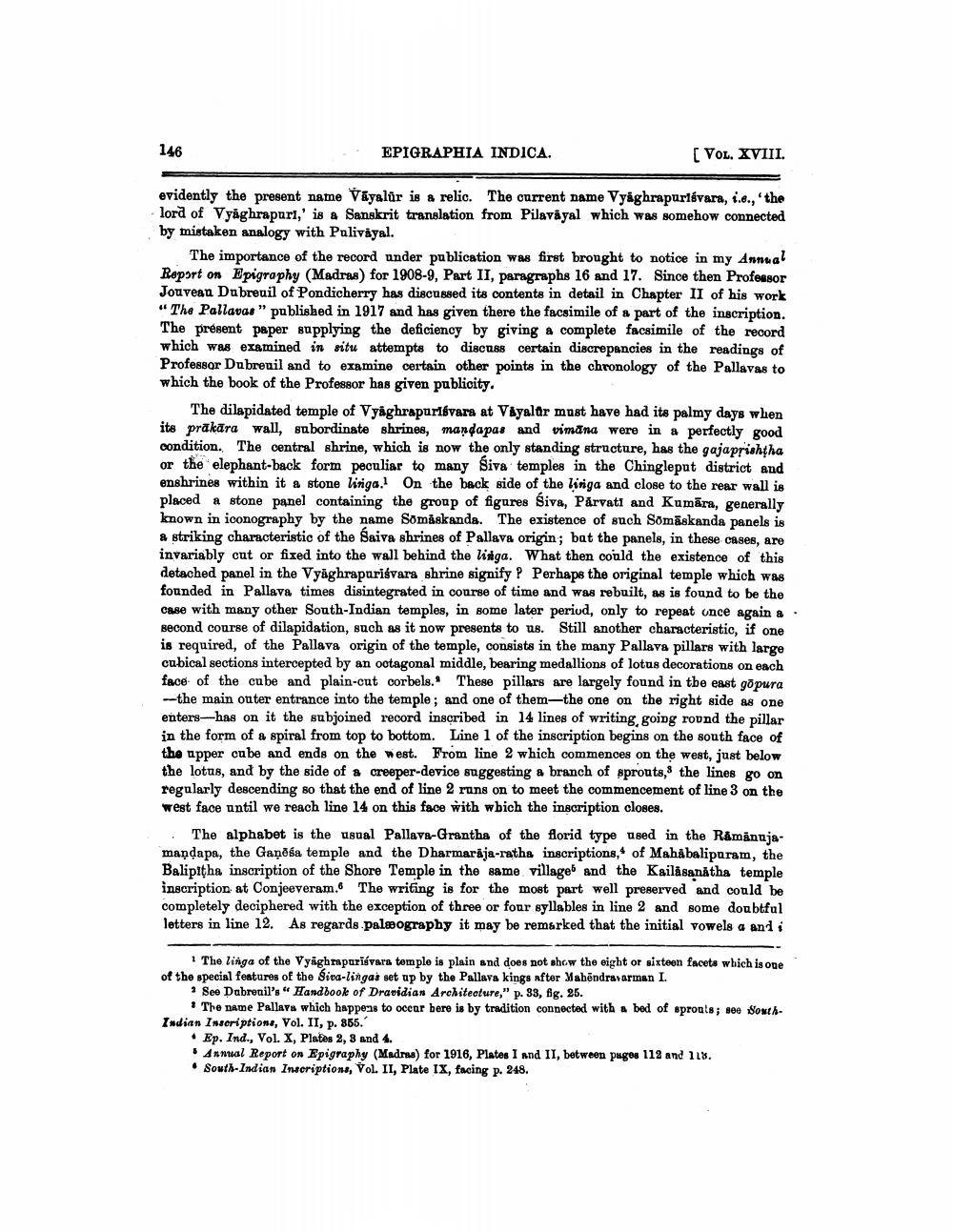________________
146
EPIGRAPHIA INDICA.
[VOL. XVIII.
evidently the present name Vayalür is a relic. The current name Vyaghrapurlévara, i.e., 'the lord of Vyaghrapuri,' is a Sanskrit translation from Pilavayal which was somehow connected by mistaken analogy with Palivayal.
The importance of the record under publication was first brought to notice in my Annual Report on Epigraphy (Madras) for 1908-9, Part II, paragraphs 16 and 17. Since then Professor Jouveau Dubreuil of Pondicherry has discussed its contents in detail in Chapter II of his work "The Pallavas" published in 1917 and has given there the facsimile of a part of the inscription. The present paper supplying the deficiency by giving a complete facsimile of the record which was examined in situ attempts to discuss certain discrepancies in the readings of Professor Dubreuil and to examine certain other points in the chronology of the Pallavas to which the book of the Professor has given publicity.
The dilapidated temple of Vyaghrapuriévara at Vayalar must have had its palmy days when its prakara wall, subordinate shrines, mandapas and vimana were in a perfectly good condition. The central shrine, which is now the only standing structure, has the gajaprishtha or the elephant-back form peculiar to many Siva temples in the Chingleput district and enshrines within it a stone linga. On the back side of the linga and close to the rear wall is placed a stone panel containing the group of figures Siva, Parvati and Kumāra, generally known in iconography by the name Somaskanda. The existence of such Somāskanda panels is a striking characteristic of the Saiva shrines of Pallava origin; bat the panels, in these cases, are invariably cut or fixed into the wall behind the linga. What then could the existence of this detached panel in the Vyaghrapuriśvara shrine signify? Perhaps the original temple which was founded in Pallava times disintegrated in course of time and was rebuilt, as is found to be the case with many other South-Indian temples, in some later period, only to repeat once again a second course of dilapidation, such as it now presents to us. Still another characteristic, if one is required, of the Pallava origin of the temple, consists in the many Pallava pillars with large cubical sections intercepted by an octagonal middle, bearing medallions of lotus decorations on each face of the cube and plain-cut corbels. These pillars are largely found in the east gopura -the main outer entrance into the temple; and one of them-the one on the right side as one enters has on it the subjoined record inscribed in 14 lines of writing, going round the pillar in the form of a spiral from top to bottom. Line 1 of the inscription begins on the south face of the upper cube and ends on the west. From line 2 which commences on the west, just below the lotus, and by the side of a creeper-device suggesting a branch of sprouts, the lines go on regularly descending so that the end of line 2 runs on to meet the commencement of line 3 on the west face until we reach line 14 on this face with which the inscription closes.
The alphabet is the usual Pallava-Grantha of the florid type used in the Rāmānujamandapa, the Ganesa temple and the Dharmaraja-ratha inscriptions, of Mahabalipuram, the Balipitha inscription of the Shore Temple in the same village and the Kailasanatha temple inscription at Conjeeveram. The writing is for the most part well preserved and could be completely deciphered with the exception of three or four syllables in line 2 and some doubtful letters in line 12. As regards paleography it may be remarked that the initial vowels a and i
1 The linga of the Vyaghraparisvara temple is plain and does not show the eight or sixteen facets which is one of the special features of the Siva-lingas set up by the Pallava kings after Mahendravarman I.
2 See Dubreuil's" Handbook of Dravidian Architecture," p. 33, fig. 25.
The name Pallava which happens to occur here is by tradition connected with a bed of sprouts; see SouthIndian Inscriptions, Vol. II, p. 355.
Ep. Ind., Vol. X, Plates 2, 3 and 4.
Annual Report on Epigraphy (Madras) for 1916, Plates I and II, between pages 112 and 118.
• South-Indian Inscriptions, Vol. II, Plate IX, facing p. 248.




